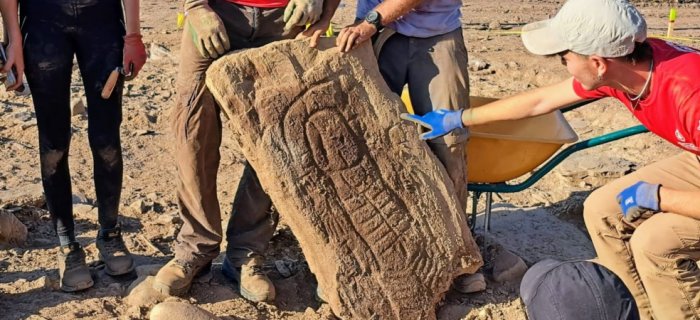Jan Bartek – AncientPages.com – For a team of archaeologists digging in southwest Spain, the discovery of a Bronze/Iron Age stela—a funerary stone slab with carvings depicting an important individual—would have been exciting enough. But to find a stela that challenges longstanding interpretations of how the carvings represent gender and social roles in prehistoric times was beyond the teams’ wildest dreams.

Image shows when the stela when it was discovered by the archaeological team. Image credit Marta Díaz-Guardamino.
The excavation, taking place in the 3000-year-old funerary complex of Las Capellanías, in Cañaveral de León, Spain, uncovered a stela depicting a human figure with detailed face, hands and feet, a headdress, necklace, two swords and male genitals.
Prior to this discovery, archaeologists had interpreted features such as a headdress and necklace on a stela as representing a female form, while the inclusion of weaponry such as swords would be interpreted as male “warrior” stelae.
But this latest discovery, including both “male” and “female” elements, challenges these ᴀssumptions.
This led the archaeology team to consider that the social roles depicted by these carvings were more fluid than previously thought, and not restricted to a specific gender, the Durham University informs in a press release.
Funerary monuments
This is the third stela to be found by the team in this location, providing archaeologists with fascinating insight into the funerary rituals of the time. The location of these finds, and the Las Capellanías funerary complex, is also significant as it is on what would have been an important natural pathway linking to main river basins—forming a communications highway of its day.
The team believes that the location of Las Capellanías on this highway is significant, showing that decorated stelae also had a role as territorial markers.
See also: More Archaeology News
The excavation was part of a fieldwork project co-directed by Dr. Marta Diaz-Guardamino in Durham University’s Department of Archaeology, as part of the wider Maritime Encounters project, with colleagues from the universities of Huelva and Seville. The team included Durham University undergraduate students, working alongside undergraduate and postgraduate students from Seville University.
Written by Jan Bartek – AncientPages.com Staff Writer





